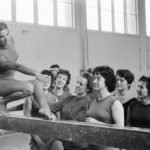In this article, I dive into an event competed by female artistic gymnasts – the Uneven Bars (UB).
With two bars closely aligned, gymnasts perform visually stunning skills that require excellent upper body strength and power. Uneven Bars have evolved a lot over time so I will explore everything about this piece of apparatus in-depth.
Let’s get into the Uneven Bars!

What are the Uneven Bars?
The Uneven Bars (UB) are also called Asymmetric Bars (AB) or simply ‘bars’ in Women’s Artistic competition. They consist of two bars that run parallel to each other but at different heights. Gymnasts mainly hang and swing around the High Bar (HB) and Low Bar (LB). Gymnasts will also jump or ‘release’ from one bar onto another as part of more advanced routines.
What are Uneven Bars made of?
The Uneven Bars are made of two main parts; the frame and two bars. The bars themselves are also called ‘rails’. Modern Uneven Bar rails are mostly made from fiberglass with a wooden veneer. This differs from the Men’s High Bar which is metal and made from steel.
The frame itself is usually hollow and made from steel.
Uneven Bars in professional gym facilities will be anchored to the ground using wires, chains and tensioners. This will keep the frame more stable whilst in use.
Some gymnastics facilities are unable to anchor the bars into the ground so will use free-standing uneven bars. These can be built to the full size but with specially designed legs that can be adjusted easily and allow the frame to be moved on wheels.
Can Uneven Bars be adjusted?
Yes, uneven bars can be adjusted in two different ways.
Firstly the height of each bar can be raised or lowered using adjusters on each side.
Secondly, the distance between the low bar and the high bar can be adjusted.
Smaller types of uneven bars like the ones for home use will have fewer adjustments compared to full-size Uneven Bars found at competitions and professional facilities. Check out my best bars for home use here.
Can Uneven Bars break?
If you are worried about the Uneven Bars breaking then you shouldn’t be. It is pretty much impossible for a gymnast to snap or break a modern professional standard bar while using it. The bars are designed to have some flex so it is normal to see them bend under the high amount of force that a gymnast creates when swinging.
However, the fiberglass used in modern bars is super-strong compared to the wooden bars of years gone by.
You would have to apply a massive amount of weight onto a modern bar before it snaps, and this couldn’t be done in ‘normal’ gymnastics training. I’ve never seen it happen in 20 years as a coach.

If you have a bar at home this will be smaller and less strong than a professional bar found in a gym so read the instructions carefully to find out the maximum amount of weight it is designed for. The Tumbl Trak Junior Bar is designed for home use and has a maximum load of 125Ibs which is a good standard.
How high are uneven bars?
The Federation of International Gymnastics (FIG) set the following rules for Uneven Bar heights for elite level competitions:
- High Bar 250cm (8.2ft)
- Low Bar 170cm (5.6ft)
During training sessions, the heights of the bars may be lower, especially to help younger gymnasts learn new skills. Training bars or ‘mini-apparatus’ are also used to train younger children and would be a lot lower than full-size FIG bars. It is common to have Uneven Bars placed over foam pits to aid the learning of new skills without the danger of a hard landing.
FIG standard Uneven Bars are 240cm (7.9ft) in length and fit into sockets attached to the frame.
The distance between the High Bar and Low Bar can be adjusted between 130cm (4.3ft) and 180cm (6.2ft).
Uneven Bars history
Most gymnastics routines and apparatus have changed dramatically over time and the uneven bars are no exception. The size, construction materials and difficulty levels are very different to the original apparatus.
When were the Uneven Bars invented?
The origins of the Uneven Bars can be traced back to the 1930s. Competitively the first elite events with Uneven Bars was the 1934 World Championships and subsequently the 1936 Olympics in Berlin. However, at this time women could still choose between competing on Rings or Bar so the first recognized appearance of Uneven Bars as a stand-alone event at the Olympics was in 1952 in Helsinki.
Originally the Uneven Bars were simply a set of Men’s Parallel Bars set at two different height bars. The differentiation between Men’s and Women’s Gymnastics was very little until the 1950s so Women would also compete at Parallel Bars and Rings, which are considered male-only events nowadays
If you are familiar with the Parallel Bars you will recognise that the bars are much closer together than modern uneven bars. In fact, they are only designed to be just wider than shoulder-width. This restricted gymnasts in the 1950s to perform simple skills like Kips and Circles. If a gymnast tried to swing, they would collide with the other bar!
When did they change the uneven bars?
During the 1960s and 70s equipment manufacturers began to make Uneven Bars specifically for female gymnasts. This moved the apparatus away from simply being a converted set of Parallel Bars.
As the Uneven Bars changed, they became wider apart and allowed for more dynamic skills to be performed including more ‘release’ skills and moves that transitioned between High and Low bars. Gymnasts such as Olga Korbut and Nadia Comaneci become household names due to their new skills on the Uneven Bars such as the ‘Korbut Flip’ and ‘Comaneci Salto’.
Additionally, the changes in the design also saw the circumference of the bar get smaller making it easier to grip and swing, especially for younger gymnasts. Girls as young as 14 would regularly take part in the Olympics so the smaller bar size would have benefited their smaller grasp.
During the 1970s fiberglass was added to the bar rails to give extra strength and stop them snapping. This was important because the new extra space between the bars allowed for harder, more powerful skills to be performed when the older solid wood bars could no longer withstand the forces being placed on them.
Uneven Bar skills
Uneven Bars skills can be categorized into the following:
Mounts
This is the skill to get onto the Uneven Bar. It could be a simple jump from the mat or a springboard can be used to give extra height. Often gymnasts will jump into a swing or ‘glide’ which helps give them momentum at the start of the routine.
Gymnasts wanting to perform a harder mount will Round Off onto the Springboard and salto onto the bar (Jentsch or Gonzalez).
Casts and Hip Circles
Casts start in a support position and allow the gymnast to get into Handstand. This is super important as Handstand is where Pirouettes are performed and Giant Swings start.
A Hip Circle rotates around the bar with the hips touching. To increase difficulty, gymnasts can add turns and Handstands into the Hip Circle.
Giant Swings
A Giant Swing rotates all the way around the bar (usually the High Bar) with the gymnast keeping their arms straight throughout. To increase difficulty, gymnasts will add turns during the swing or harder still, they will release from the bar, perform a somersault, then re-catch the bar. Examples of these release bars include Tkatchev and the Jaeger-Salto.
Stalder Circles
Stalder Circles are performed in a straddle position. It should start and finish in the Handstand position and can also be performed with turns and even flight between High Bar and Low Bar. The skill is named after Swiss gymnast Josef Stalder who originated the move and also became Olympic Champion at the 1948 London games.
Dismounts
At the end of a routine, the gymnast needs to let go of the bar and return to the mat, hopefully landing on their feet! To begin with, gymnasts will simply release at the end of a swing but as they become more advanced, somersaults are added. Somersault dismounts become harder with twists and double somersaults.
The perfect landing will be completely still with no steps. This is known as sticking the landing.
What are the hardest Uneven Bar skills?
Using the FIG Code of Points it is possible to see the hardest skills in terms of difficulty value. These skills are listed as F or G in the Code of Points. According to the current Code of Points some of the hardest skills include:
- Triple Somersalt Dismount. The gymnast has to swing forwards before releasing into a Triple Backwards somersalt and landing on the mat. The skill is known as the Magaña after Mexican gymnast Brenda Magaña Almaral who first competed the triple back dismount at the 2002 World Championships.
- Double Twisting Double Somersalt Dismount. The gymnast has to swing forwards before releasing into the Double Double in a Layout position. The skills is named after Elise Ray of the USA who successfully landed the skill at the 2000 Olympics.
- The Khristakieva is performed by swinging forwards, releasing the bar into a backwards somersalt with 1 and a half twists before re-catching the bar. Bulgarian gymnast Snezhana Khristakieva was the first female gymnast to perform the skill on Uneven Bars. The skill is also known as the Def after male gymnast Jacques Def who first performed the same skill on High Bar.
Banned Skills on Uneven Bars
Several moves have been banned by the FIG as they are now deemed too dangerous to perform. These include:
- The Korbut Flip. From a standing position on the High Bar, Olga Korbut performed a back tuck before catching the bar again. However, the FIG outlawed standing on the Bar for safety reasons.
- Back Layout. The gymnast would start with toes on the High Bar before performing a Back Layout over the Low Bar to land on the mat.
- Mukhina Salto. A standing somersalt just like the Korbut Flip but with an added full twist. Named after Soviet gymnast Elena Mukhina who was paralyzed in a training accident just two weeks before the 1980 Olympic Games.
Uneven Bars Competition Scoring
At elite level competitions, the 8 highest difficulty skills, including the dismount, are counted towards the routine difficulty score (DV). Gymnasts can increase their difficulty score by including specific Composition Requirements (CR) and Connection Values (CV) in their routine.
An example of a CR bonus would be a flighted element from High Bar to Low Bar.
At big competitions such as World Championships and Olympic Games, one set of judges will be responsible for adding the difficulty score together and the execution judges will award a score out of 10 depending on how well the routine is performed. The D-score and E-Score are added together to give a total score.
This format of scoring means the ‘perfect 10’ is no longer possible.
Who are the best gymnasts at Uneven Bars?
Gymnasts that have medaled at the Olympics or have moves named after them can be considered as some of the best at Uneven Bars!
- Nina Derwael – Belgium
- Anastasia Ilyankova – Russia
- Sunisa Lee – USA
- Aliya Mustafina – Russia
- Madison Kocian – USA
- Sophie Scheder – Germany
- He Kexin – China
- Beth Tweddle – Great Britain
- Nastia Liukin – USA
- Émilie Le Pennec – France
- Svetlana Khorkina – Russia
- Lu Li – China
- Daniela Silivaș – Romania
- Nadia Comăneci – Romania
- Olga Korbut – Soviet Union
- Wei Xiaoyuan – China
Sources
FIG Womens Artistic Code of Points
- A Complete Guide to Gymnastics Hand Rips
 Are you tired of dealing with painful gymnastics rips on your hands from training? Look no further – this article offers a comprehensive approach to… Read more: A Complete Guide to Gymnastics Hand Rips
Are you tired of dealing with painful gymnastics rips on your hands from training? Look no further – this article offers a comprehensive approach to… Read more: A Complete Guide to Gymnastics Hand Rips - Is Gymnastics Dangerous? (Facts and Comparisons)
 Gymnastics is acknowledged as a highly technical and physically demanding sport. It inherently carries a risk of injury, which is why most coaches and clubs… Read more: Is Gymnastics Dangerous? (Facts and Comparisons)
Gymnastics is acknowledged as a highly technical and physically demanding sport. It inherently carries a risk of injury, which is why most coaches and clubs… Read more: Is Gymnastics Dangerous? (Facts and Comparisons) - The Fascinating Evolution of Gymnastics (History and Facts)
 Gymnastics is a sport that has been around for centuries and has evolved significantly throughout history. From its origins in ancient Greece to the modern-day… Read more: The Fascinating Evolution of Gymnastics (History and Facts)
Gymnastics is a sport that has been around for centuries and has evolved significantly throughout history. From its origins in ancient Greece to the modern-day… Read more: The Fascinating Evolution of Gymnastics (History and Facts) - The Ultimate Parallel Bars Skills List
 Parallel bars are one of the most challenging events in men’s gymnastics. Mastering the right moves first on parallel bars is essential to improving your… Read more: The Ultimate Parallel Bars Skills List
Parallel bars are one of the most challenging events in men’s gymnastics. Mastering the right moves first on parallel bars is essential to improving your… Read more: The Ultimate Parallel Bars Skills List - The Long-Term Effects of Gymnastics on the Body (A Complete Guide)
 While gymnastics can offer many benefits, such as improved fitness and self-confidence, many people also ask what are the Long-Term Effects of Gymnastics on the… Read more: The Long-Term Effects of Gymnastics on the Body (A Complete Guide)
While gymnastics can offer many benefits, such as improved fitness and self-confidence, many people also ask what are the Long-Term Effects of Gymnastics on the… Read more: The Long-Term Effects of Gymnastics on the Body (A Complete Guide) - What Age Does Competitive Gymnastics Start?
 Ever wondered what age does competitive gymnastics start? It’s well known that gymnasts start training at a young age to develop the skills and strength… Read more: What Age Does Competitive Gymnastics Start?
Ever wondered what age does competitive gymnastics start? It’s well known that gymnasts start training at a young age to develop the skills and strength… Read more: What Age Does Competitive Gymnastics Start?
